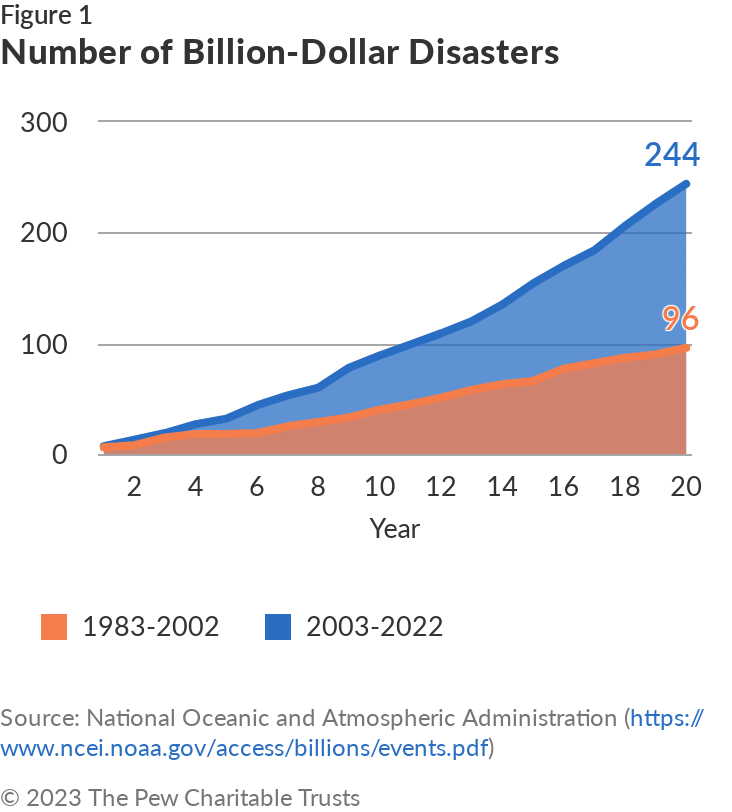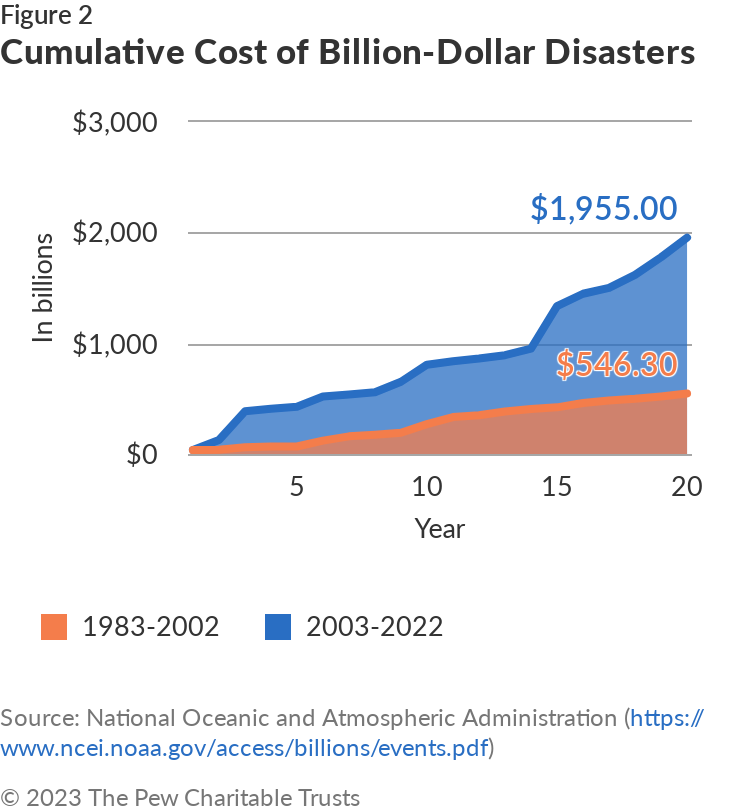What’s Driving the Boom in Billion-Dollar Disasters? A Lot
Factors range from extreme weather and population migration to changes in land use and ill-advised development

Historically in the U.S., wildfires burned mostly in sparsely populated areas of vast Western states. But that’s changed in recent years, with Hawaii’s island of Maui the latest location of a devastating fire that devoured homes, businesses, and cultural landmarks, along with rain forest and agricultural land. The fire claimed at least 97 lives—already the highest wildfire death toll in modern U.S. history, with many more still unaccounted for—and is projected to cost billions of dollars in damage and other economic losses. Elsewhere, major wildfires have caused significant impacts in unlikely states, including the Tiger Island wildfire in Louisiana and the Rock Pond wildfire in Rhode Island.
Unfortunately, these events are not outliers, with major weather disasters becoming increasingly common. Pew analyzed National Oceanic and Atmospheric Administration (NOAA) data on billion-dollar weather and climate disasters since 1980 and found a significant increase in both the frequency and the cost of billion-dollar disasters during the 20-year period from 2003 to 2022 compared with the previous 20-year period from 1983 to 2002. In the first 20-year period, 96 disasters caused more than $546.3 billion in damage and other costs. These figures rose to 244 events and more than $1.95 trillion in costs in the subsequent 20 years—marking a 154% increase in the number of billion-dollar disasters and a 257% surge in costs. More alarming, this trend appears likely to continue: At this writing, the U.S. had already endured 23 billion-dollar disasters in 2023, surpassing the 2020 record of 20 such disasters, with more than three months still left in the year.
Billion Dollar Disasters Take a Growing Toll
Data from the National Oceanic and Atmospheric Administration show dramatic increases over the past 40 years in the frequency (Figure 1) and cost (Figure 2) of weather and climate disasters in the U.S. in which overall damages/costs reached or exceeded $1 billion. These graphics compare the periods 1983-2002 and 2003-2022; the dollar figures represent the 2023 Consumer Price Index cost-adjusted value.


More frequent and costly disasters are becoming a "new normal" and should spur policymakers, at all levels of government, into action. Pew has identified several root causes leading to the escalating number and costs of billion-dollar disasters, along with recommendations on how to address them.
Climate change. The summer of 2023 saw multiple record-high temperatures around the world, including the highest global mean surface air temperature—63.01 degrees Fahrenheit—ever recorded on July 6. This came amid an unprecedented wildfire season in Canada and a winter and spring of intense storms, including record and near-record precipitation across the Western U.S. For example, between December 2022 and March 2023, California experienced at least 12 significant atmospheric rivers—streams of moisture-laden air coursing from the tropics to higher latitudes—that buried homes in snow, buckled roofs, blocked roads, and led to heavy flooding in some areas. Then, in August, Hilary became the first tropical storm to hit Southern California in 84 years. In late August, Florida endured its second major hurricane in as many years, one that is estimated to have led to at least $2.2 billion in insured losses. Also in August, NOAA’s Climate Prediction Center increased its prediction for the 2023 Atlantic hurricane season from “near-normal” activity to “above-normal” in response to record sea temperatures.
In many cases, major disasters have compounding effects that create a vicious cycle. Extreme heat can exacerbate drought conditions, increasing wildfire risk. Wildfires leave behind barren landscapes, where vegetation would otherwise reduce runoff, increasing flood risk and leaving hillsides vulnerable to mudslides. Heavier-than-normal precipitation can increase vegetation growth, which in turn serves as fuel for wildfires. And so on. Regardless of where you live, chances are you’ve experienced or witnessed at least one dramatic effect of climate change.
The challenge: How to anticipate and plan for current—and future—climate-related disasters?
Solutions: In the past, disaster planning was often based solely on historic weather patterns and impacts, but as the jump in billion-dollar disasters indicates, that backward-facing approach is an inadequate way to prepare for the future. Instead, policymakers must work to better understand the key factors driving risk today and develop myriad scenarios for potential future conditions. By examining the underlying causes of risk and vulnerability, states, counties, and cities can plan for their current and future climate reality, taking proactive actions to identify high-risk areas, design infrastructure (such as stormwater systems) with appropriate capacity, develop safety factors, and maximize the natural landscape’s ability to combat impacts of flooding, wildfire, extreme heat, and drought.
Population distribution. According to NOAA, more than 128 million Americans (nearly 40% of the population) live in coastal shoreline counties, with 40% of those residents falling into demographic categories that can be associated with elevated risk, including the elderly or those living in poverty. Yet, researchers at the University of Southern California have estimated that up to 13 million coastal residents could be displaced by 2100 as a consequence of sea-level rise.
Additionally, population migrations from one state to another can increase disaster risk, in part because pressure for new development can result in more people living in high-risk areas, such as housing developments that have not been designed to withstand future potential impacts. Another factor is simple math: more people already living in disaster-prone places. For example, the two fastest-growing states in the country—Florida and Texas—rank second and sixth, respectively, for the most disaster declarations between January 2022 and May 2023, according to FEMA statistics.
The challenge: How to help residents understand risk within their own communities, or communities they are considering moving to?
Solutions: Understanding risk and vulnerability can help people decide where they are going to live and prepare for disasters once they make that decision. People also benefit from understanding insurance rate structures and future affordability, particularly as FEMA and private sector insurers adjust rates to account for increasing risk. Additionally, requiring that owners properly disclose a property’s flood history to potential purchasers and renters would help them make better-informed choices about where to live. For communities that have already suffered through disasters such as flooding, buyout programs—which are designed to purchase at-risk properties for redevelopment into green space or another compatible use—can be a key tool for helping residents move to higher ground.
Land use and development. As populations grow and shift—both as part of population influxes into high disaster risk area and as part of "managed retreat" away from disaster risk—governments and developers must make judicious decisions about where and how to build. Land uses and development decisions that fail to account for current and potential future risk can also lead to increased impacts from climate disasters. For example, a recent study from the University of North Carolina showed that for each residence removed through a buyout, more than 10 new residences have been built in that state’s flood plains, countering the beneficial impacts of buyout activities.
Additionally, new development can alter the natural landscape and lead to increased risk. Between 1996 and 2016, the U.S. lost 640,000 acres of wetlands, much of it to new development. With the loss of these wetlands, surrounding communities also lost the benefits those wetlands provided, including the ability to absorb floodwaters, reduce the impact of coastal storm surges, store water as a buffer against droughts, and act as a fire break to limit the spread of wildfire. In Western states, development is pushing closer to woodlands, which could additionally heighten wildfire risk, and the growth of cities in arid climates may lead to ground and surface water scarcity, exacerbating drought conditions.
The challenge: How to ensure that land use and development decisions do not inadvertently increase people’s risk and vulnerability to climate-related disaster impacts?
Solutions: State governments should take a regional approach to development planning and should incorporate both historic climate data and predictive models that illustrate multiple scenarios for future conditions. These plans should account for future conditions in the siting, design, permitting, and development of homes, businesses, and public facilities. Land use planners should also consider how new development may affect the natural landscape and should protect or restore green space, such as wetlands and other nature-based solutions that are proven to reduce long-term impacts of climate-related disasters.
The increasing prevalence and cost of billion-dollar disasters should set off alarm bells for policymakers and the public. However, without a serious discussion about underlying factors that increase risk, it will be difficult to stem the tide of catastrophic disasters across the U.S.
Mathew Sanders is a senior officer leading state resilience policy for Pew’s U.S. Conservation program.














